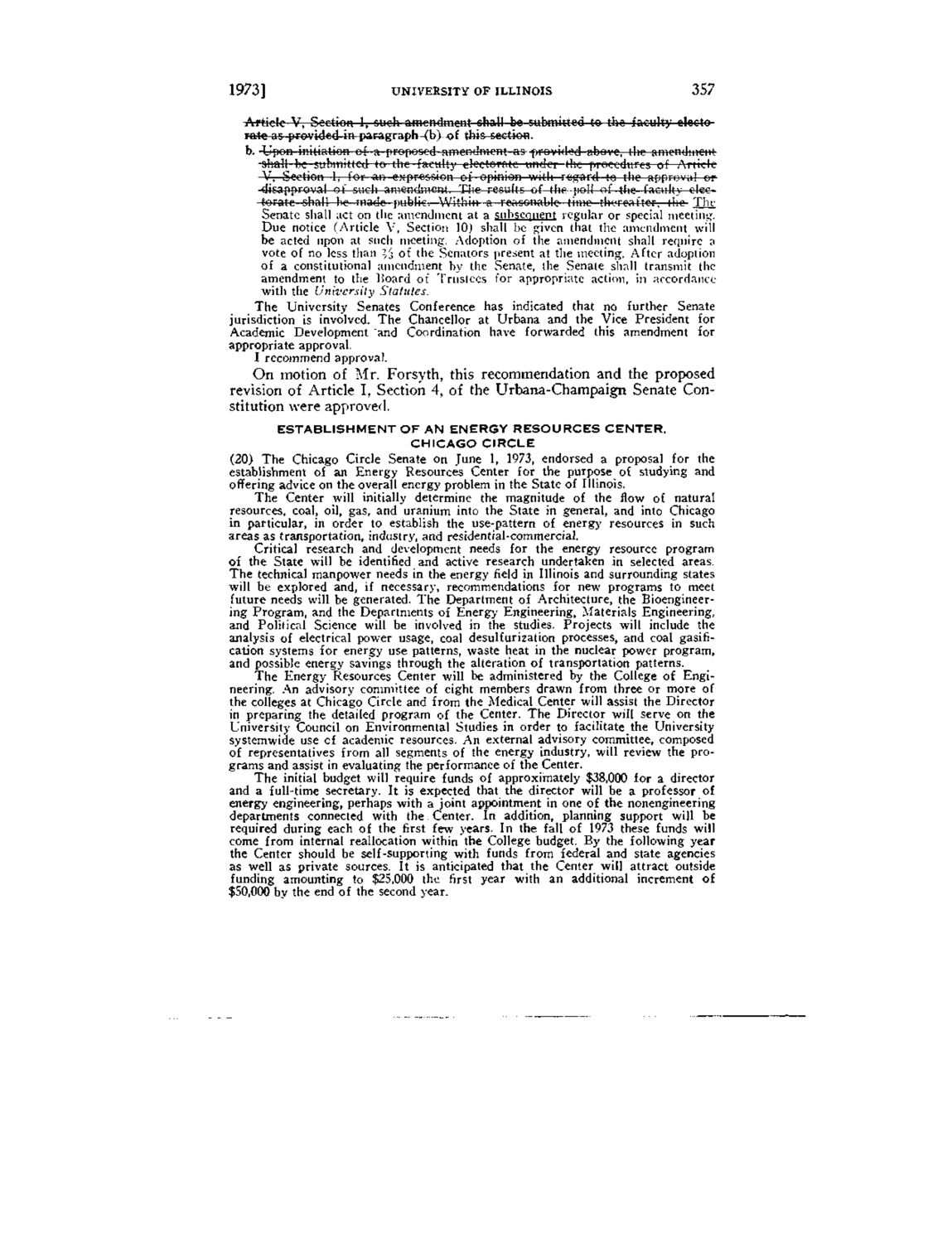| |
| |
Caption: Board of Trustees Minutes - 1974
This is a reduced-resolution page image for fast online browsing.

EXTRACTED TEXT FROM PAGE:
1973] UNIVERSITY OF ILLINOIS 357 Article-V, Section 1, such amendment shall be submitted to the faculty electorate a5-proYtded-ia-par-agraph-(b) of this section. b. -Upon initiation of-a-proposed amendment as-provided above, the amendment •shall he submitted- to- the-faculty electorate under the procedures of Article V, Section 1; for••-an—expression of opinion with regard to the approval or Senate shall act on the amendment at a subsequent regular or special meeting. Due notice (Article V, Section 10) shall he ^iven that the amendment will be acted upon at such meeting. Adoption of the amendment shall require ;i vote of no less than ?/s of the Senators present at the meeting. After adoption of a constitutional amendment by the Senate, the Senate shall transmit the amendment to ttie Hoard of Trustees for appropriate action, in accordance with the University Statutes. The University Senates Conference has indicated that no further Senate jurisdiction is involved. The Chancellor at Urbana and the Vice President for Academic Development "and Coordination have forwarded this amendment for appropriate approval. I recommend approval. On motion of Mr. Forsyth, this recommendation and the proposed revision of Article I, Section 4, of the Urbana-Champaign Senate Constitution were approved. ESTABLISHMENT OF AN ENERGY RESOURCES CENTER. CHICAGO CIRCLE (20) The Chicago Circle Senate on June 1, 1973, endorsed a proposal for the establishment of an Energy Resources Center for the purpose of studying and offering advice on the overall energy problem in the State of Illinois. The Center will initially determine the magnitude of the flow of natural resources, coal, oil, gas, and uranium into the State in general, and into Chicago in particular, in order to establish the use-pattern of energy resources in such areas as transportation, industry, and residential-commercial. Critical research and development needs for the energy resource program of the State will be identified and active research undertaken in selected areas. The technical manpower needs in the energy field in Illinois and surrounding states will be explored and, if necessary, recommendations for new programs to meet future needs will be generated. The Department of Architecture, the Bioengineering Program, and the Departments of Energy Engineering, Materials Engineering, and Political Science will be involved in the studies. Projects will include the analysis of electrical power usage, coal desulfurization processes, and coal gasification systems for energy use patterns, waste heat in the nuclear power program, and possible energy savings through the alteration of transportation patterns. The Energy Resources Center will be administered by the College of Engineering. An advisory committee of eight members drawn from three or more of the colleges at Chicago Circle and from the Medical Center will assist the Director in preparing the detailed program of the Center. The Director will serve on the University Council on Environmental Studies in order to facilitate the University systemwide use cf academic resources. An external advisory committee, composed of representatives from all segments of the energy industry, will review the programs and assist in evaluating the performance of the Center. The initial budget will require funds of approximately $38,000 for a director and a full-time secretary. It is expected that the director will be a professor of energy engineering, perhaps with a joint appointment in one of the nonengineering departments connected with the Center. In addition, planning support will be required during each of the first few years. In the fall of 1973 these funds will come from internal reallocation within the College budget. By the following year the Center should be self-supporting with funds from federal and state agencies as well as private sources. It is anticipated that the Center will attract outside funding amounting to $25,000 the first year with an additional increment of $50,000 by the end of the second year.
| |